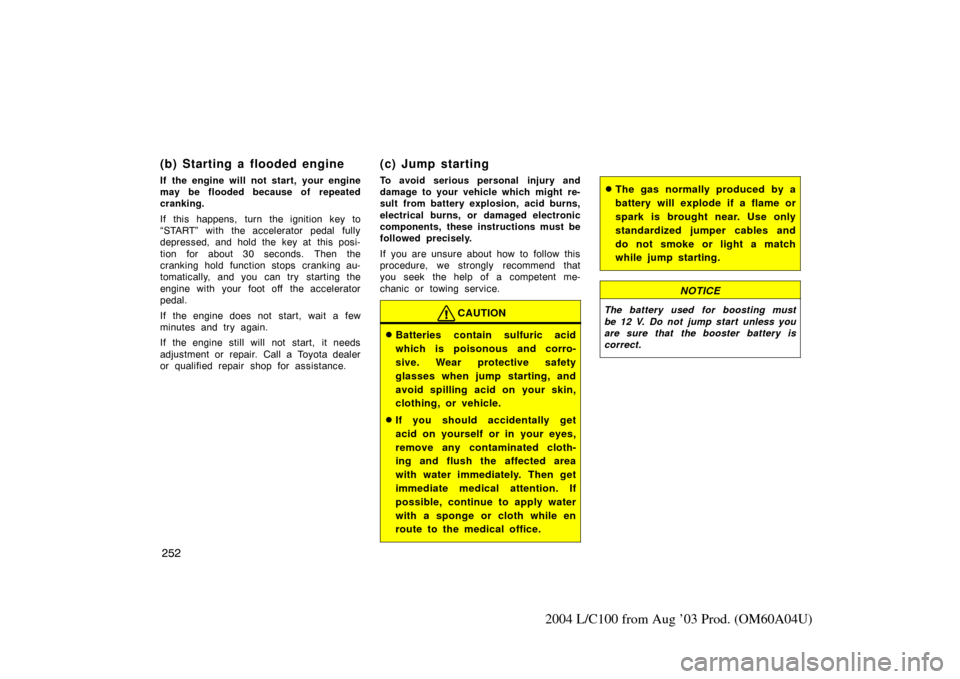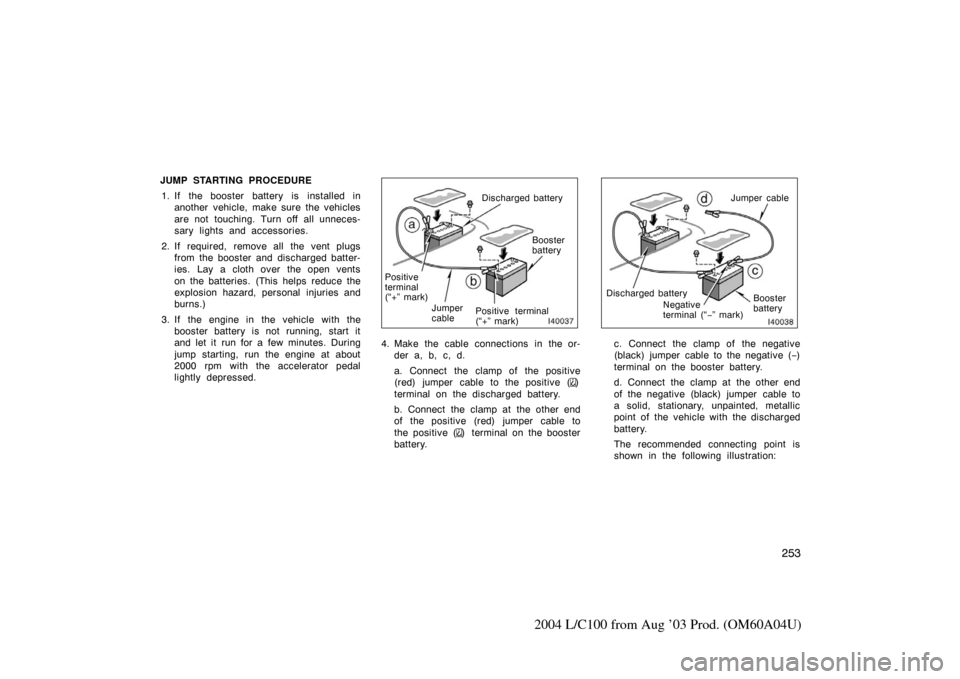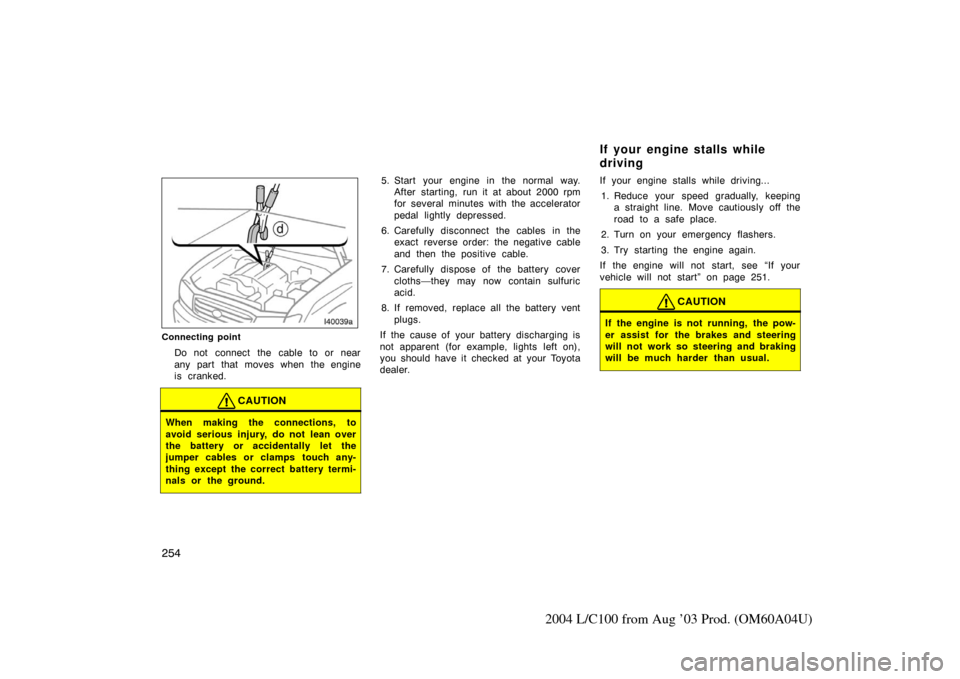Page 247 of 342

239
2004 L/C100 from Aug ’03 Prod. (OM60A04U)
Winter driving tips
Make sure your coolant is properly pro-
tected against freezing.
Only use “Toyota Super Long Life Coolant”
or similar high quality ethylene glycol
based non−silicate, non −amine, non− nitrite,
and non− borate coolant with long −life
hybrid organic acid technology.
See “Checking the engine coolant level”
on page 296 for details of coolant type
selection.
“Toyota Super Long Life Coolant” is pre-
mixed with 50% coolant and 50% deion-
ized water. This coolant provides protec-
tion down to about –35 °C (–31 °F).
NOTICE
Do not use plain water alone.
Check the condition of the battery and
cables.
Cold temperatures reduce the capacity of
any battery, so it must be in top shape
to provide enough power for winter start-
ing. It tells you how to visually inspect the
battery on page 310. Your Toyota dealer
and most service stations will be pleased
to check the level of charge. Make sure the engine oil viscosity is
suitable for the cold weather.
See page 295 for recommended viscosity.
Leaving a heavy summer oil in your ve-
hicle during winter months may cause
harder starting. If you are not sure about
which oil to use, call your Toyota dealer–
he will be pleased to help.
Keep the door locks from freezing.
Squirt lock de
−icer or glycerine into the
locks to keep them from freezing.
Use a washer fluid containing an anti-
freeze solution.
This product is available at your Toyota
dealer and most auto parts stores. Follow
the manufacturer ’s directions for how
much to mix with water.NOTICE
Do not use engine antifreeze or any
other substitute as washer fluid be-
cause it may damage your vehicle’s
paint.
Do not use your parking brake when
there is a possibility it could freeze.
When parking, put the transmission into
“P” and block the front wheels. Do not
use the parking brake, or snow or water
accumulated in and around the parking
brake mechanism may freeze, making it
hard to release.
Keep ice and snow from accumulating
under the fenders.
Ice and snow built up under your fenders
can make steering difficult. During bad
winter driving, stop and check under the
fenders occasionally.
Depending on where you are driving,
we recommend you carry some emer-
gency equipment.
Some of the things you might put in the
vehicle are tire chains, window scraper,
bag of sand or salt, flares, small shovel,
jumper cables, etc.
Page 260 of 342

252
2004 L/C100 from Aug ’03 Prod. (OM60A04U)
(b) Starting a flooded engine
If the engine will not start, your engine
may be flooded because of repeated
cranking.
If this happens, turn the ignition key to
“START” with the accelerator pedal fully
depressed, and hold the key at this posi-
tion for about 30 seconds. Then the
cranking hold function stops cranking au-
tomatically, and you can try starting the
engine with your foot off the accelerator
pedal.
If the engine does not start, wait a few
minutes and try again.
If the engine still will not start, it needs
adjustment or repair. Call a Toyota dealer
or qualified repair shop for assistance.
(c) Jump starting
To avoid serious personal injury and
damage to your vehicle which might re-
sult from battery explosion, acid burns,
electrical burns, or damaged electronic
components, these instructions must be
followed precisely.
If you are unsure about how to follow this
procedure, we strongly recommend that
you seek the help of a competent me-
chanic or towing service.
CAUTION
�Batteries contain sulfuric acid
which is poisonous and corro-
sive. Wear protective safety
glasses when jump starting, and
avoid spilling acid on your skin,
clothing, or vehicle.
�If you should accidentally get
acid on yourself or in your eyes,
remove any contaminated cloth-
ing and flush the affected area
with water immediately. Then get
immediate medical attention. If
possible, continue to apply water
with a sponge or cloth while en
route to the medical office.
�The gas normally produced by a
battery will explode if a flame or
spark is brought near. Use only
standardized jumper cables and
do not smoke or light a match
while jump starting.
NOTICE
The battery used for boosting must
be 12 V. Do not jump start unless you
are sure that the booster battery is
correct.
Page 261 of 342

253
2004 L/C100 from Aug ’03 Prod. (OM60A04U)
JUMP STARTING PROCEDURE1. If the booster battery is installed in another vehicle, make sure the vehicles
are not touching. Turn off all unneces-
sary lights and accessories.
2. If required, remove all the vent plugs from the booster and discharged batter-
ies. Lay a cloth over the open vents
on the batteries. (This helps reduce the
explosion hazard, personal injuries and
burns.)
3. If the engine in the vehicle with the booster battery is not running, start it
and let it run for a few minutes. During
jump starting, run the engine at about
2000 rpm with the accelerator pedal
lightly depressed.
Discharged battery
Positive
terminal
(“+” mark) Jumper
cable Booster
battery
Positive terminal
(“+” mark)
4. Make the cable connections in the or- der a, b, c, d.
a. Connect the clamp of the positive
(red) jumper cable to the positive (
)
terminal on the discharged battery.
b. Connect the clamp at the other end
of the positive (red) jumper cable to
the positive (
) terminal on the booster
battery.
Discharged battery Booster
battery
Negative
terminal (“
−” mark) Jumper cable
c. Connect the clamp of the negative
(black) jumper cable to the negative (
−)
terminal on the booster battery.
d. Connect the clamp at the other end
of the negative (black) jumper cable to
a solid, stationary, unpainted, metallic
point of the vehicle with the discharged
battery.
The recommended connecting point is
shown in the following illustration:
Page 262 of 342

254
2004 L/C100 from Aug ’03 Prod. (OM60A04U)
Connecting point
Do not connect the cable to or near
any part that moves when the engine
is cranked.
CAUTION
When making the connections, to
avoid serious injury, do not lean over
the battery or accidentally let the
jumper cables or clamps touch any-
thing except the correct battery termi-
nals or the ground.
5. Start your engine in the normal way.After starting, run it at about 2000 rpm
for several minutes with the accelerator
pedal lightly depressed.
6. Carefully disconnect the cables in the exact reverse order: the negative cable
and then the positive cable.
7. Carefully dispose of the battery cover cloths—they may now contain sulfuric
acid.
8. If removed, replace all the battery vent plugs.
If the cause of your battery discharging is
not apparent (for example, lights left on),
you should have it checked at your Toyota
dealer. If your engine stalls while driving...
1. Reduce your speed gradually, keeping a straight line. Move cautiously off the
road to a safe place.
2. Turn on your emergency flashers.
3. Try starting the engine again.
If the engine will not start, see “If your
vehicle will not start” on page 251.
CAUTION
If the engine is not running, the pow-
er assist for the brakes and steering
will not work so steering and braking
will be much harder than usual.
If your engine stalls while
driving